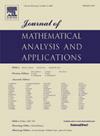Global solvability for the heat equations in two half spaces and an interface
IF 1.2
3区 数学
Q1 MATHEMATICS
Journal of Mathematical Analysis and Applications
Pub Date : 2025-09-08
DOI:10.1016/j.jmaa.2025.130050
引用次数: 0
Abstract
This paper considers the existence of a global-in-time strong solution to the heat equations in the two half spaces , , and the interface . We introduce and study some function spaces in the two half spaces and the interface. We apply our function spaces and the maximal -regularity for Hilbert space-valued functions to show the existence of a local-in-time strong solution to our heat equations. By using an energy equality of our heat system, we prove the existence of a unique global-in-time strong solution to the system with large initial data. The key idea of constructing strong solutions to our system is to make use of nice properties of the heat semigroups and kernels for , , and . In Appendix, we derive our heat equations in the two half spaces and the interface from an energetic point of view.
两个半空间和界面热方程的全局可解性
本文考虑了两个半空间R+3(= r2x(0,∞))、R - 3(= r2x(−∞,0))和界面r2x {0}(=R2)上热方程的整体时强解的存在性。介绍并研究了两个半空间中的函数空间及其界面。我们应用函数空间和Hilbert空间值函数的极大lp正则性来证明热方程的局部时强解的存在性。利用热系统的能量等式,证明了具有大初始数据的热系统存在唯一的全局实时强解。构造系统强解的关键思想是利用R+3, R - 3和R2的热半群和核的良好性质。在附录中,我们从能量的角度推导了两个半空间和界面中的热方程。
本文章由计算机程序翻译,如有差异,请以英文原文为准。
求助全文
约1分钟内获得全文
求助全文
来源期刊
CiteScore
2.50
自引率
7.70%
发文量
790
审稿时长
6 months
期刊介绍:
The Journal of Mathematical Analysis and Applications presents papers that treat mathematical analysis and its numerous applications. The journal emphasizes articles devoted to the mathematical treatment of questions arising in physics, chemistry, biology, and engineering, particularly those that stress analytical aspects and novel problems and their solutions.
Papers are sought which employ one or more of the following areas of classical analysis:
• Analytic number theory
• Functional analysis and operator theory
• Real and harmonic analysis
• Complex analysis
• Numerical analysis
• Applied mathematics
• Partial differential equations
• Dynamical systems
• Control and Optimization
• Probability
• Mathematical biology
• Combinatorics
• Mathematical physics.

 求助内容:
求助内容: 应助结果提醒方式:
应助结果提醒方式:


